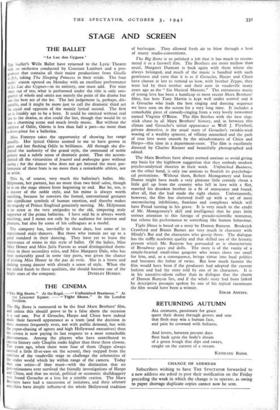STAGE AND SCREEN
THE BALLET
,6 Le Lac des Cygnes ' THE Sadler's Wells Ballet have returned to the Lyric Theatre with an orchestra conducted by Constant Lambert and a pro- gramme that contains all their major productions from Giselle to Job, taking The Sleeping Princess in their stride. The four weeks' season opened on Monday with an excellent performance of Le Lac des Cygnes—in its entirety, one must add. For nine times out of ten, what is performed under the title is only one- quarter of whole and omits not merely the point of the drama but also the best act of the lot. The last judgement is, perhaps, dis- putable, and it might be more just to call the dramatic third act the equal and opposite of the mainly lyrical second. The first act is frankly apt to be a bore. It could be omitted without real loss to the drama, as also could the last, though that would be to lose a charming scene and much lovely music. But without the contrast of Odile, Odette is less than half a part—no more than
show-piece for a ballerina.
Miss Fonteyn takes the opportunity of showing her range grandly. Her lyrical Odette seemed to me to have grown in grace and her flashing Odile in brilliance. All through she dis- played the authority of the grand style, the command of noble gesture and a subtle sense of dramatic point. That she accom- plished all the virtuosities of fouette and arabesque goes without saying ; for the dancer who does not get beyond the mere per- formance of these feats is no more than a remarkable athlete, not an artist.
This is, of course, very much the ballerina's ballet. Mr. Helpmann, her partner, has no more than two brief solos, though he is on the stage almost from beginning to end. But he, too, is a master of the noble style, and his mime is always worth watching, because he converts the formal, conventional gestures into significant symbols of human emotion, and thereby makes the tragedy of Prince Siegfried genuinely moving. Mr. Helpmann is an actor at the very antipodes to the old, simpering male supporter of the prima ballerina. I have said he is always worth watching, and I mean not only by the audience for interest and pleasure, but also by some of his colleagues as a model.
The company has, inevitalily in these days, lost some of its experienced male• dancers. But those who remain are up to a good standard in their dancing. They have yet to learn the Importance of mime in this style of ballet. Of the ladies, Miss Mary Honer and Miss Julia Farron as usual distinguished them- selves in their secondary roles, and Miss Margaret Dale, who has been noticeably good in some tiny parts, was given the chance of joining Miss Honer in the pas de trots. She is a brave and dashing young dancer with already a sense of style. When she has added finish to these qualities, she should become one of the


























 Previous page
Previous page